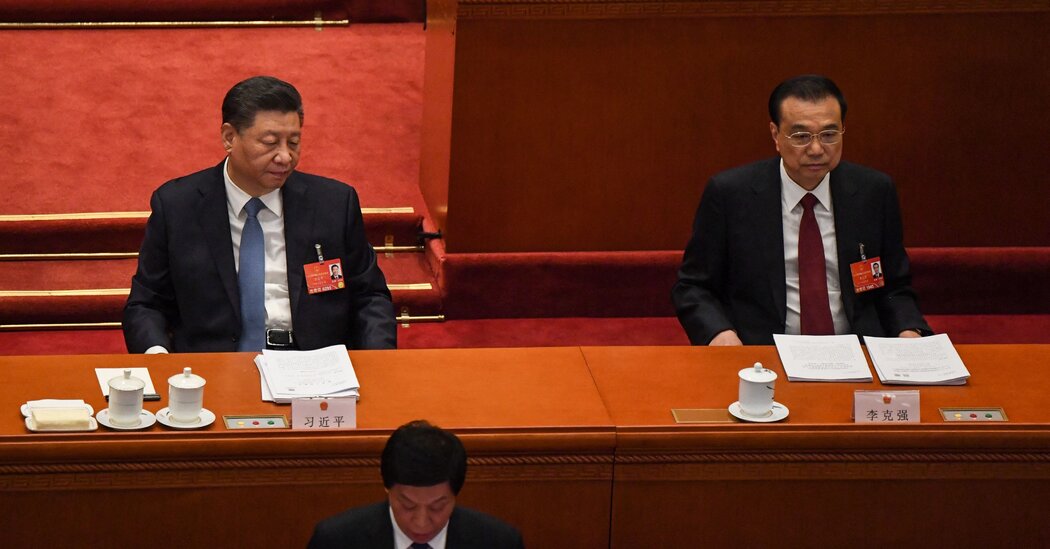
BEIJING — Plowing past global anxieties over the war engulfing Ukraine, China set its economy on a course of steady expansion for 2022, prioritizing growth, job creation and increased social welfare in a year when the national leader, Xi Jinping, is poised to claim a new term in power.
The annual government work report delivered to China’s National People’s Congress by Premier Li Keqiang on Saturday did not even mention Russia’s invasion of Ukraine, and it took an implacably steady-as-it-goes tone on China’s economic outlook.
The implicit message appeared to be that China could weather the turbulence in Europe, and would focus on trying to keep the Chinese population at home contented and employed before an all-important Communist Party meeting in the fall, when Mr. Xi is increasingly certain to extend his time in power.
“In our work this year, we must make economic stability our top priority and pursue progress while ensuring stability,” Mr. Li said.
By announcing a target for China’s economy to expand “around 5.5 percent” this year, Mr. Li reinforced the government’s emphasis on shoring up growth in the face of global uncertainty from the coronavirus pandemic and the war in Ukraine. That goal is slower than the 8.1 percent rebound in the economy that China reported last year, but higher than many economists believe the country can achieve without big government spending programs.
Mr. Li disappointed anyone who might have thought he would have anything to say about Ukraine. The Chinese government’s annual work reports generally avoid new announcements on foreign policy, and this year’s was no exception. Beijing has sought to maintain its partnership with Russia while trying to distance China from President Vladimir V. Putin’s decision to go to war.
“China will continue to pursue an independent foreign policy of peace, stay on the path of peaceful development, work for a new type of international relations,” Mr. Li said in his report — the closest he came to a comment on international developments.
Still, leaders in Beijing also signaled — in numbers, rather than words — that they were preparing for an increasingly dangerous world. China’s military budget will grow by 7.1 percent this year to about $229 billion, according to the government’s budget report, also released Saturday. Mr. Li indicated that there would be no slowing in China’s efforts to modernize and overhaul its military, which includes expanding the navy and developing an array of advanced missiles.
“While economic development provides a foundation for a possible defense budget increase, the security threats China is facing and the demands for national defense capability enhancement caused by those threats are the driving factors,” Global Times, a Communist Party-run newspaper, wrote in a report this week that predicted China’s rise in military spending. “Over the past year, the U.S. also rallied its allies and partners around the world to provoke and confront China militarily.”
In December, the United States Congress approved a budget of $768 billion for the American military. But salaries and equipment manufacturing costs are far higher in the United States, which has prompted some analysts to suggest that China’s military budget is rapidly catching up in actual purchasing power.
The plan Mr. Li outlined suggests that China values economic growth more than trying to make potentially painful adjustments to shift the economy toward greater reliance on domestic consumer spending. Beijing has been trying, with limited success, to move the economy away from dependence on debt-fueled infrastructure and housing construction.
China had managed to reduce slightly last year its debt relative to economic output. It needed to do so because this ratio had climbed, during the first year of the pandemic, to a level that economists regarded as unsustainable.
But meeting this year’s growth target would require more borrowing, undoing most or all of the progress made last year in reducing the debt burden, said Michael Pettis, an economist with Peking University. He said that it was hard to see how China could break its dependence on achieving high growth targets at least partly through heavy borrowing.
Mr. Li acknowledged that the Chinese economy would face challenges this year, pointing to the sluggish recovery of consumption and investment, flagging growth in exports and a shortage of resources and raw materials. By the last three months of last year, the economy was growing only 4 percent.
Part of that economic slowdown reflected a series of government policy shifts aimed at reining in unsustainable expansion in some sectors. Housing speculation was discouraged. Stringent limits were imposed on the after-school tutoring industry. And national security agencies imposed tighter scrutiny on the tech sector.
China’s huge construction industry is stalling as home buyers turn wary, with developers beginning to default on debts. Dwindling revenues from land sales have made some local governments more cautious about building additional roads and bridges. Continued lockdowns and travel restrictions to prevent the coronavirus from spreading have caused a downturn in spending at hotels and restaurants.
Mr. Li gave few clues to whether China might shift away from its stringent “zero Covid” pandemic strategy, which has relied on mass testing and occasional lockdowns. He urged officials to handle local outbreaks in a “scientific and targeted manner.”
The Latest on China: Key Things to Know
He also separately alluded to the widespread public outrage that erupted in recent weeks over the abduction of women and children. “We will crack down hard on the trafficking of women and children and protect their lawful rights and interests,” he said.
The outcry was set off after a blogger posted footage of a woman seen shackled in a windowless hut in east-central China’s Jiangsu Province, who had reportedly given birth to eight children. Official investigators said the woman had been abducted in 1998, a finding that people on social media said exposed longstanding problems with bride trafficking and inadequate protections for women. The woman became a symbol of injustice, and censors have since sought to delete online discussions of her. (Mr. Li did not mention her.)
To bolster the economy, Mr. Li issued a government budget for this year that called for extra spending, and the issuance of more bonds to pay for it.
The central government, which has fairly little debt, will increase by 18 percent this year its transfers of money to provincial and local governments, many of which are heavily indebted. The provincial and local governments carry out much of China’s social spending and infrastructure construction.
Social welfare and education outlays are both set to increase about 10 percent this year. That includes increased central government support for China’s old-age pension funds, which have to support a fast-expanding population of retirees. The budget also includes heavy spending to help rural families and to build more rental housing.
Many Chinese provinces have set their own growth targets at 7 percent or higher, as the Communist Party seeks to reassure the public that economic expansion remains a vital goal, said Feng Chucheng, a partner at Plenum, a political and economic consulting firm in Beijing. “They need to project a picture where the party puts growth targets as a top priority,” he said.
Keith Bradsher reported from Beijing, and Chris Buckley from Sydney. Li You, Liu Yi and Claire Fu contributed research.




